 Sample Route
Sample Route
Enjoy Ise to the fullest with a route that includes classic Japan at Ise Shrine, Japanese food at Okage Yokocho, and dressing up like a samurai or ninja at Ise Azuchi Momoyama Cultural Village. Finally, delight in the view of the sea of Japan and the Meoto Iwa. Use this route for ideas when building your own itinerary.
9:00 Iseshi Ekimae (in front of Iseshi Station)
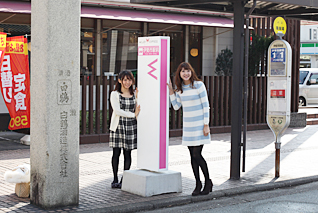
Highway coach buses have been innovating, and you can select from seats that are easy on the back and legs. There are also added comforts for female travelers seeking comfort and safety.
We slept like rocks, and now we're in Ise and ready to, well, "rock!"

Walk (approximately 10 minutes)
9:15 Ise Shrine Geku ("the outer shrine")
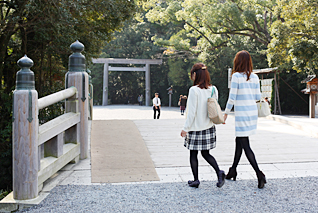
It was surprisingly close to the station.
The Sengukan at the outer shrine was replete with historic exhibits on Ise Shrine and quite a sight to see.

Walk (approximately 10 minutes)
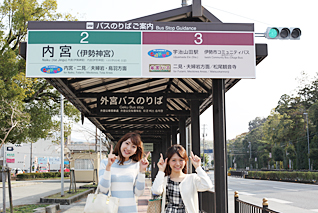
There is a touring bus that leaves from the outer shrine that we will catch to get there. The ride takes about 10 minutes.
This bus makes a circuit around the area and is very convenient, making stops at Iseshi Station, the Kawasaki Shoninkan ("Kawasaki Merchant Museum"), which preserves the feel of an Edo period(1603-1868) merchants' quarters, and the Meoto Iwa.

Bus (approximately 10 minutes)
11:30 Matsuo Kannon-ji Temple
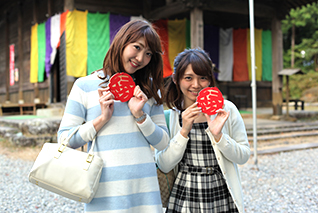
The plaque bears the character en (meaning "relationship" or "bond"). The design is quite snazzy, though, isn't it?
We picked our fortunes together, but we both got chukichi ("moderate luck") -- nothing to write home about!

Bus (approximately 10 minutes)

Next is a transfer to the touring bus at the same stop and a trip to Ise Shrine Naiku, the "inner shrine."
The bus makes a convenient circuit of Ise Azuchi Momoyama Cultural Village, the Meoto Iwa, and the Toba area, so it's perfect for seeing the Ise Shrine environs.

Bus (approximately 10 minutes)
12:15 Ise Shrine Naiku
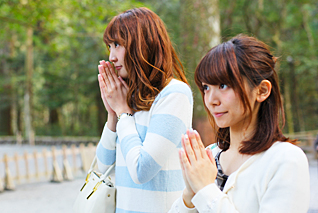
Shrouded in greenery, the inner shrine is tranquil and stately, making you feel as if your soul has been cleansed.
There is a set of stones in the inner shrine known as "Mitsuishi" that are famous as a so-called "power spot", since it is alleged that you can feel warmth if you wave your hand over them.
Even former Prime Minister Aso purportedly felt energy after waving his hand over "Mitsuishi".

Walk (approximately 10 minutes)
13:30 Okage Yokocho
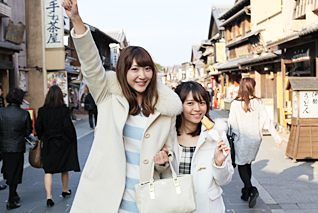
With all the tasty-looking food - Henba mochi, rich fried cheese stick, unohana donuts - we can’t make up our minds.

Walk (approximately two minutes)
13:30 Sushikyu (Tekone-zushi)

Tekone-zushi is a kind of sushi with raw red-meat fish marinated in a sauce and mixed with vinegared rice.
Tekone-zushi is said to have originated in the Shima area as a meal that bonito tuna fishermen could easily make, allegedly beginning when these fishermen mixed together chunked bonito fish and seasonings with the vinegared rice they brought along with them (the name Tekone-zushi is said to come from the words te, meaning "hand," and koneru, meaning to "knead" or "mix," since the fishermen mixed the rice and fish together by hand).

Walk (approximately two minutes)
15:00 Akafuku mochi Honten
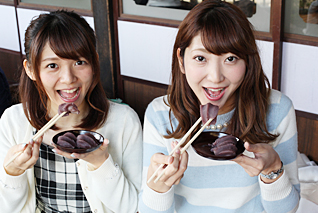

Travel on foot (approximately five minutes)
15:10 Naiku-mae
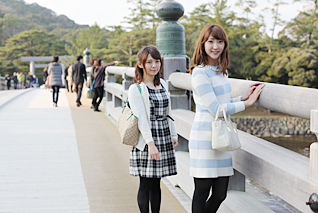

Bus (approximately 20 minutes)
15:40 Ise Azuchi Momoyama Cultural Village
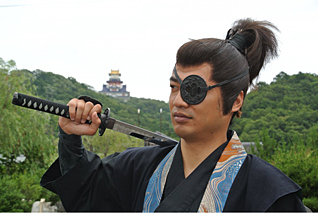
With a townscape that looks like it came right out of a Japanese period drama, the village is jam-packed with attractions such as ninja action shows, live action theater, a ninja house, and a haunted house.
At the "Makeover Photo Building", you can choose from 100 kinds of Azuchi-Momoyama period garb to dress up in! Talk about fun!

Bus (approximately 10 minutes)
17:00 Futami Okitama Shrine and Meoto Iwa
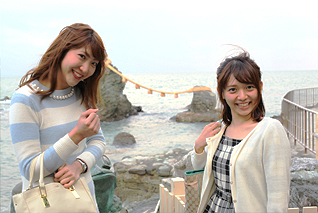
There were loads of frog statues around Meoto Iwa. The statues, playing on the word for frog in Japanese, kaeru - which can also mean "return" - were allegedly dedicated as talismans to, for example: "return safely", "have lost items returned", and "return to youth".

Walk

Stay overnight near Futami

